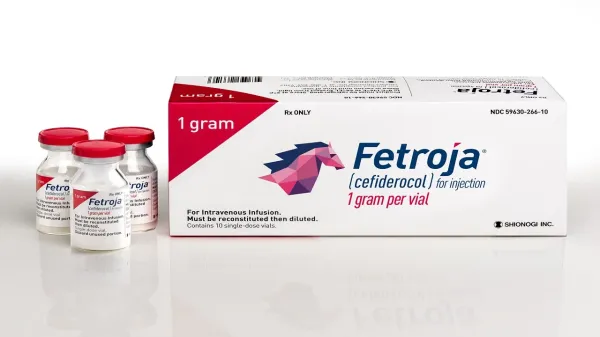Fetroja Disease Interactions
There are 3 disease interactions with Fetroja (cefiderocol).
Antibiotics (applies to Fetroja) colitis
Major Potential Hazard, Moderate plausibility. Applicable conditions: Colitis/Enteritis (Noninfectious)
Clostridioides difficile-associated diarrhea (CDAD), formerly pseudomembranous colitis, has been reported with almost all antibacterial drugs and may range from mild diarrhea to fatal colitis. The most common culprits include clindamycin and lincomycin. Antibacterial therapy alters the normal flora of the colon, leading to overgrowth of C difficile, whose toxins A and B contribute to CDAD development. Morbidity and mortality are increased with hypertoxin-producing strains of C difficile; these infections can be resistant to antimicrobial therapy and may require colectomy. CDAD must be considered in all patients who present with diarrhea after antibacterial use. Since CDAD has been reported to occur more than 2 months after antibacterial use, careful medical history is necessary. Therapy with broad-spectrum antibacterials and other agents with significant antibacterial activity should be administered cautiously in patients with history of gastrointestinal disease, particularly colitis; pseudomembranous colitis (generally characterized by severe, persistent diarrhea and severe abdominal cramps, and sometimes associated with the passage of blood and mucus), if it occurs, may be more severe in these patients and may be associated with flares in underlying disease activity. Antibacterial drugs not directed against C difficile may need to be stopped if CDAD is suspected or confirmed. Appropriate fluid and electrolyte management, protein supplementation, antibacterial treatment of C difficile, and surgical evaluation should be started as clinically indicated.
Beta-lactams (parenteral) (applies to Fetroja) renal dysfunction
Moderate Potential Hazard, Moderate plausibility.
Most beta-lactam antibacterial agents are eliminated by the kidney as unchanged drug and, in some cases, also as metabolites. The serum concentrations of beta-lactam antibacterial agents and their metabolites may be increased, and the half-lives prolonged, in patients with impaired renal function. Neurotoxic reactions (e.g., encephalopathy, aphasia, asterixis, myoclonus, seizures, nonconvulsive status epilepticus, coma) have been reported in such patients treated parenterally with these agents. Dosage adjustments may be necessary, and modifications should be based on the degree of renal dysfunction as well as severity of infection in accordance with the individual manufacturer product information. Renal function tests should be performed periodically during prolonged and/or high-dose therapy since nephrotoxicity and alterations in renal function have occasionally been associated with the use of these drugs.
Cephalosporins (applies to Fetroja) seizure disorders
Moderate Potential Hazard, Moderate plausibility. Applicable conditions: Seizures
Cephalosporins have been implicated in triggering seizures. Nonconvulsive status epilepticus, encephalopathy, coma, asterixis, neuromuscular excitability, and myoclonia have been reported with cephalosporins, particularly in patients with a history of epilepsy and/or when recommended dosages of cephalosporins were exceeded due to renal dysfunction. Dosage should be adjusted based on the degree of renal function. Anticonvulsant therapy should be continued in patients with known seizure disorders. If CNS adverse reactions including seizures occur, patients should undergo a neurological evaluation to determine whether treatment should be discontinued.
Switch to professional interaction data
Fetroja drug interactions
There are 56 drug interactions with Fetroja (cefiderocol).
More about Fetroja (cefiderocol)
- Fetroja consumer information
- Check interactions
- Compare alternatives
- Pricing & coupons
- Drug images
- Side effects
- Dosage information
- During pregnancy
- FDA approval history
- Drug class: other cephalosporins
- Breastfeeding
- En español
Related treatment guides
Drug Interaction Classification
| Highly clinically significant. Avoid combinations; the risk of the interaction outweighs the benefit. | |
| Moderately clinically significant. Usually avoid combinations; use it only under special circumstances. | |
| Minimally clinically significant. Minimize risk; assess risk and consider an alternative drug, take steps to circumvent the interaction risk and/or institute a monitoring plan. | |
| No interaction information available. |
See also:
Further information
Always consult your healthcare provider to ensure the information displayed on this page applies to your personal circumstances.


